The truth is that this article was due months ago. I started off strong, and then hit a snag. The initial proposal seemed simple enough: that the body, as both a metaphorical and physical site of contention throughout history, is more capable of understanding and representing (and possibly healing through somatic experiencing techniques) socio-political realities than either words or images. And thus within the field of fine art, body-based performance art offers perhaps the most relevant media for digesting and discussing current events that deal with and effect the body directly.
I wanted to narrow my focus specifically to performance art surrounding the #metoo movement – a social media hashtag created to highlight the widespread sexual misconduct perpetrated against women in all sectors of society. The label went viral in the United States 2017 and reverberated around the globe. I assumed that surely, as this movement so directly relates to the female body, to feminism, and to a widespread audience both within and outside of the fine art sphere, that performance artists would be on the vanguard of creating work that would break down and metabolize these issues.
When I first proposed #metoo as the topic for this article, I had recently come across Somatic Experiencing – a therapy modality that focuses on the physical sensations experienced in trauma and post traumatic stress disorder (PTSD). “Somatic Experiencing attempts to promote awareness and release physical tension that remains in the aftermath of trauma.” 1
- Scaer, Robert C.: The Trauma Spectrum. Hidden Wounds and Human Resiliency. W.W. Norton & Company, N.Y. & London, 2005
More specifically, Somatic Experiencing, commonly abbreviated SE, has become increasingly popular as a tool to move through sexual trauma, birth trauma, and abuse. I was interested in SE as a lens through which to view current body-based performance art dealing with the #metoo movement. With this understanding in mind, I hypothesized that body-based performance offers the most apt discourse on and processing of our current reality and collective trauma(s).
The skin is our largest sensory organ. There are more neurons in our gut than in our brain. Recent studies suggest that trauma (as well as pleasure) is stored not in the mind, but in the body itself, and that haptic therapies might be far more effective methods of healing than traditional talk therapy. At heart most people know this. A specific smell, sound, texture, or play of light can bring back vivid memories in more shocking detail than an image or retelling of the event, and thus can make the experience more immediately accessible.
I googled, I searched, I asked friends and colleagues. I posted an open question on social media. I referenced major art magazines. I didn’t find anything. Or rather, I found a remarkable absence. Where are the body-based performance pieces addressing issues of power dynamics and sexual predation in the workplace? There were musical numbers, theater performances, street-level actions, and several strong visual art initiatives in the US, Norway, and around the world, but I found next to nothing in performance art directly addressing current issues of the female body under threat. Am I ignorant? Am I not looking in the right places? Not asking the right people? Regardless, with #metoo taking over headlines in the last several years, surely related performance art shouldn’t be a niche interest?
What I did find is that the basic tenant of my theory is sound. The use of the body via performance art to confront, question, critique, digest, and heal past and present socio-cultural issues is nothing new – albeit it is still powerful. Regarding haptic theory and somatic practices’ relevance to performance, Andrea Pagnes states in her article Notes on Performance art, the body and the political: “At the empirical level, the body - as an entity to be protected, regulated, punished, included, excluded, etc. - is itself the object of politics. Yet, more fundamentally, our experiences of politics are embodied; we don’t merely think politics, we do and feel it.” 2 Here I might add that we don’t merely think art, we do and feel it. She goes on to say: “…Here the performer’s body continues to serve as a political arena. It is the tool of resistance while using the body as a site for political transformation.” 3
- https://www.researchcatalogue.net/view/343455/343456
- https://www.researchcatalogue.net/view/343455/343456
Although I’m not aware of SE techniques being consciously employed by artists, it’s obvious that performance art has the ability to arouse the autonomic nervous system, the primary system controlling the fight-flight-freeze response in situations of perceived danger. And thus also performance art contains the potential to move participants through disturbing sensations and return them again to a more regulated state through the “discharge” of negative physical sensations that arise in the remembering of specific threatening situations. There are numerous historical examples of feminist artists employing the body in various ways to discuss then-current socio-political issues. A few examples that immediately come to mind are:
Ana Mendietta’s 1973 performance Untitled (Rape Scene) in which she recreated the rape and murder of Sarah Ann Otten, a nursing student at the University of Iowa. Mendietta was quoted as saying “‘I think all my work has been like that – a personal response to a situation ... I can’t see being theoretical about an issue like that.” And later that she created the performance ‘as a reaction against the idea of violence against women.’ 4
- https://www.tate.org.uk/art/artworks/mendieta-untitled-rape-scene-t13355
In this instance, the artist positioned her own body as the victims was found, remaining stripped from the waist down and splayed across a table for over an hour while viewers entered through a door left ajar. It was during this time period that the Dutch clinical psychologist Peter A. Levine was beginning to create what would later be coined Somatic Experiencing, though it’s highly doubtful that Mendietta would have come into contact with his work. However she employs similar strategies in her work. When she inserted her body into that setting through her performance, she embodied the traumatic experience of another. Through her action, she stimulated a response and allowed both herself and the participants that evening to at least begin to process what had happened.
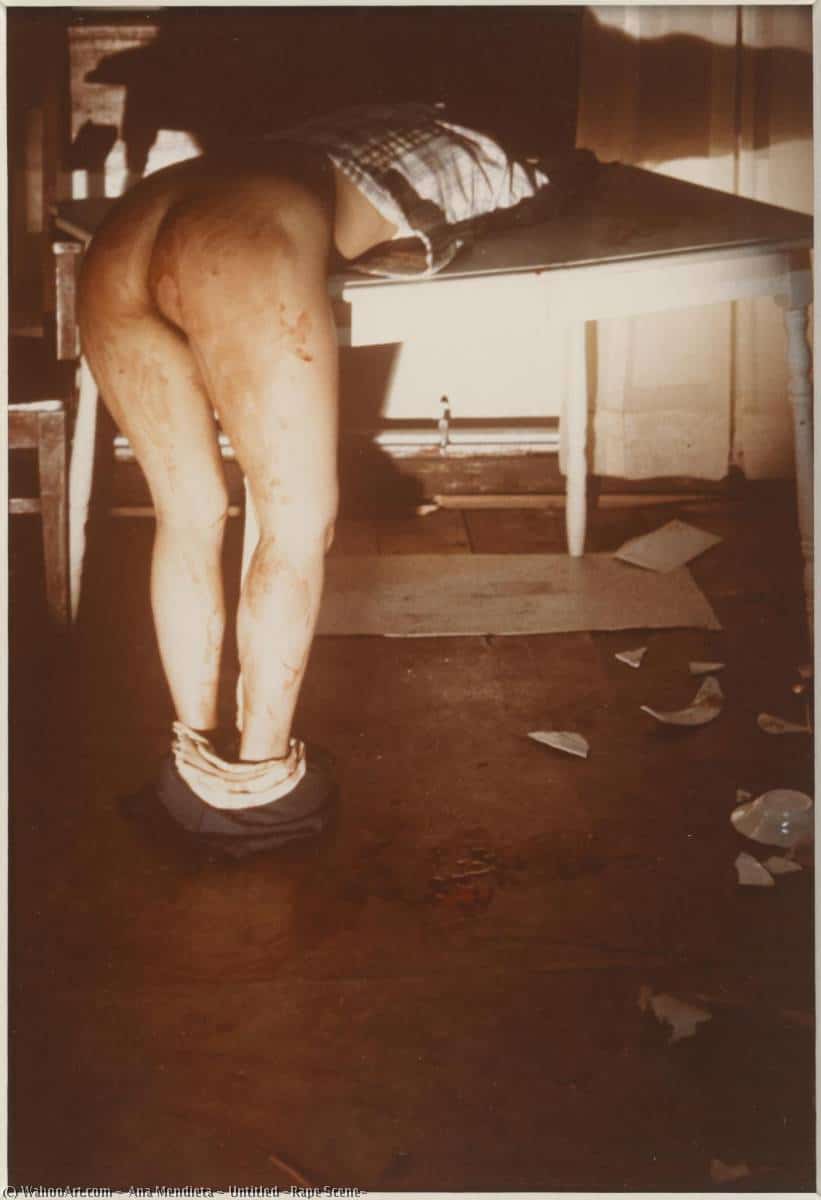


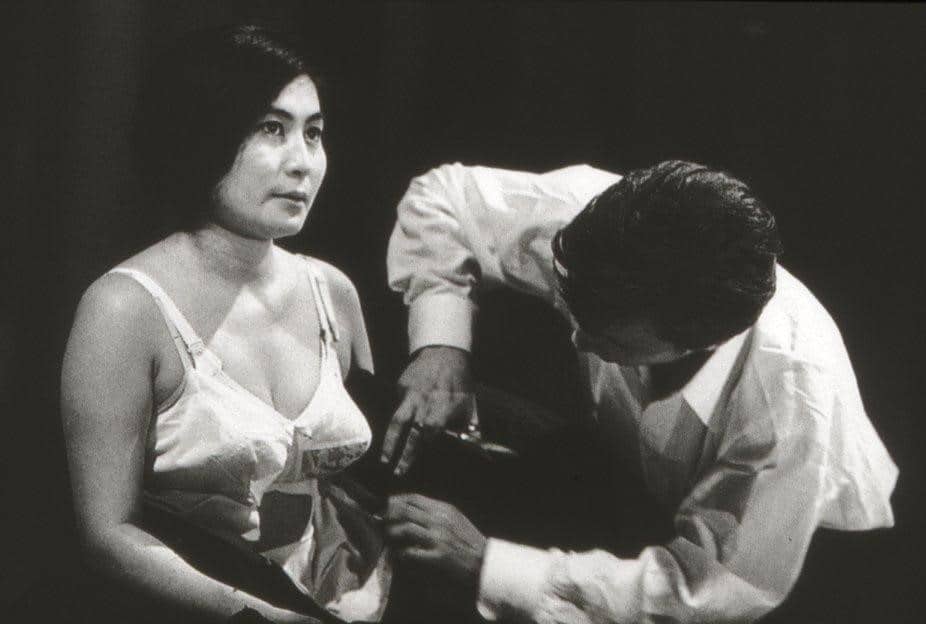
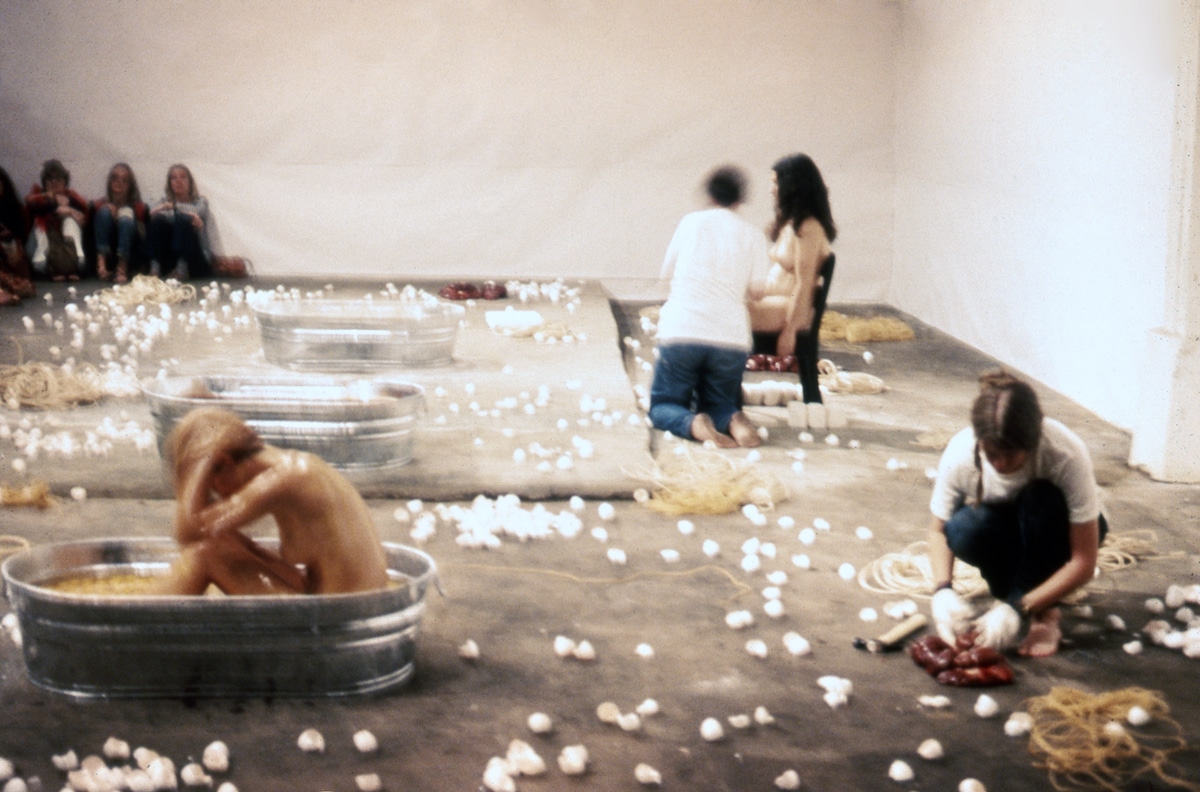
Though perhaps less straightforward, Carolee Schneeman’s performances Meat Joy, 1964 and Interior Scroll, 1975, also pop into my head. Cut Piece, originally performed by Yoko Ono in Kyoto in 1964 could also be deemed relevant, although different and adverse interpretations of this piece have been presented, including by the artist herself. There are innumerable other body-based performances that sprouted during second-wave feminism that employ various techniques similar to those used in SE today. While these historical works provide rich context, lineage, and inspiration, I’m left bereft of current practices taking over from where these artists left off.
Tangentially, I found a wealth of recent examples of body-based performance being employed by black artists to physically process the rampant racism, police violence, and the subsequent riots and #blacklivesmatter movement that have spread across the United States. In June of this year, American artist Dread Scott year referenced historical slavery and the sugar trade by dragging 75 feet of steel chain and two 50lb bags of sugar through Järnvågsplatsen in Gothenburg, Sweden. As the end of his performance route, he used a hammer and chisel to break the chains that had bound him. Similar to Mendietta’s performance, Dread Scott inserted his body into the traumatic situation of another and allowed himself to feel the literal weight of the chains that bound them. However in this example, the artist took it one step further and broke the chain, an action most likely desired by the enslaved peoples but impossible to implement. He not only embodied the trauma, but also provided a way out of it, thus symbolically completing or “discharging” the trauma stuck in the body of enslaved peoples and their descendants. 5
- https://www.dreadscott.net/works/unchained-at-jarnvagsplatsen/
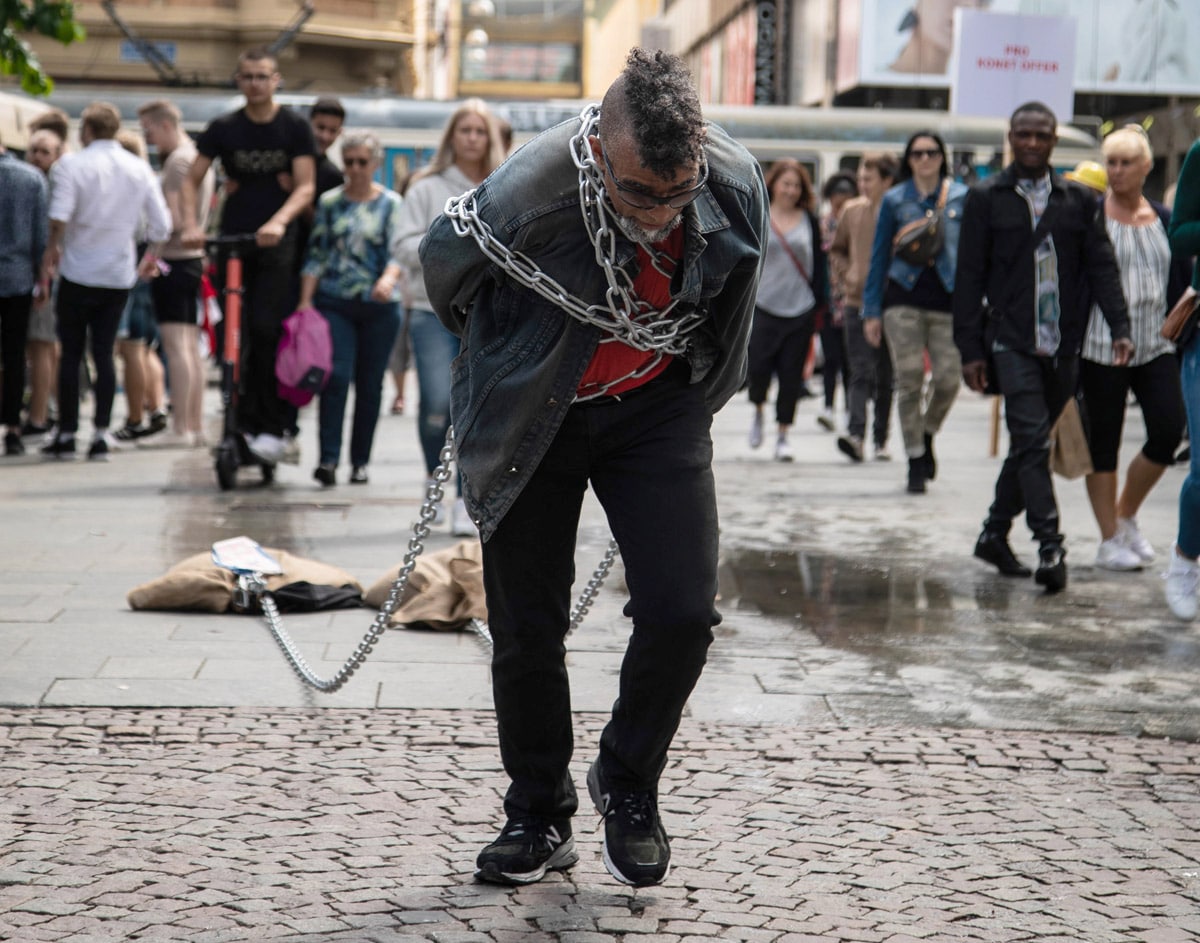
While assisting in a performance evening at New York’s downtown gallery Participant Inc., I witnessed a performance by Wilmer Wilson IV in which the young artist held up a thick sheet of bullet proof glass between himself and the audience and repeatedly spit angrily on the glass, continuing for as long as he could hold the glass at a right angle until he dropped it. In the performance, Wilson moved through both the rage and exhaustion created by the current socio-political conditions. The same night, artist Rafael Sanchez danced frenetically while quoting various philosophical texts on punishment and imprisonment, representing with the body the frantic “dance” people of color have to do to avoid such results. There are so many others: Brennan Gerard and Ryan Kelly’s ongoing project P.O.L.E. (People, Objects, Language, Exchange), Jaamil Olawale Kosoko’s #negrophobia performance, and the work of Ligia Lewis who investigates the limits of empathy in popular and relational representations of black people. I could list pages of examples. Performance art is used to embody and process issues around gender politics, the queer community, immigrant rights and deportation, even animal rights and gentrification. But where are the performances about the #metoo movement? Are issues of sexual misconduct and abuse of power against women still taboo? Or too painful to process collectively?
I did eventually find two actions worth mentioning, relevant as they involve the issues I mentioned and the female body as confrontational tool, if not directly related to #metoo: The first is a re-imagining of Leslie Labowitz’s performance Myths of Rape by feminist artists and collaborators Elana Mann and Audrey Chan. In the original piece, female volunteers were dressed in black, blindfolded, and carried posters that stated myths about sexual assault “such as rape occurs only amongst strangers” and “it could never happen to me.” The artists re-imagined the performance in 2012 at Los Angeles Contemporary Exhibitions (LACE) as part of the Getty Pacific Standard Time Performance Festival. Mann and Chan’s re-staging of the performance nearly 35 years later clearly echoed the original, but the blindfolds were no longer present and the signs were now worn on the bodies themselves “to signify the sexually assaulted body as the site of trauma.” The revised edition also notably included male performers and included Facts as well as Myths. The multiple bodies present, wearing the cultural myths of rape, served as a poignant illustration of the status quo. However the performance acted more as a public service announcement drawing attention to a critical issue, rather than a fully embodied movement through trauma as outlined by Somatic Experiencing theory. 6
- https://www.againstviolence.art/myths-recreation
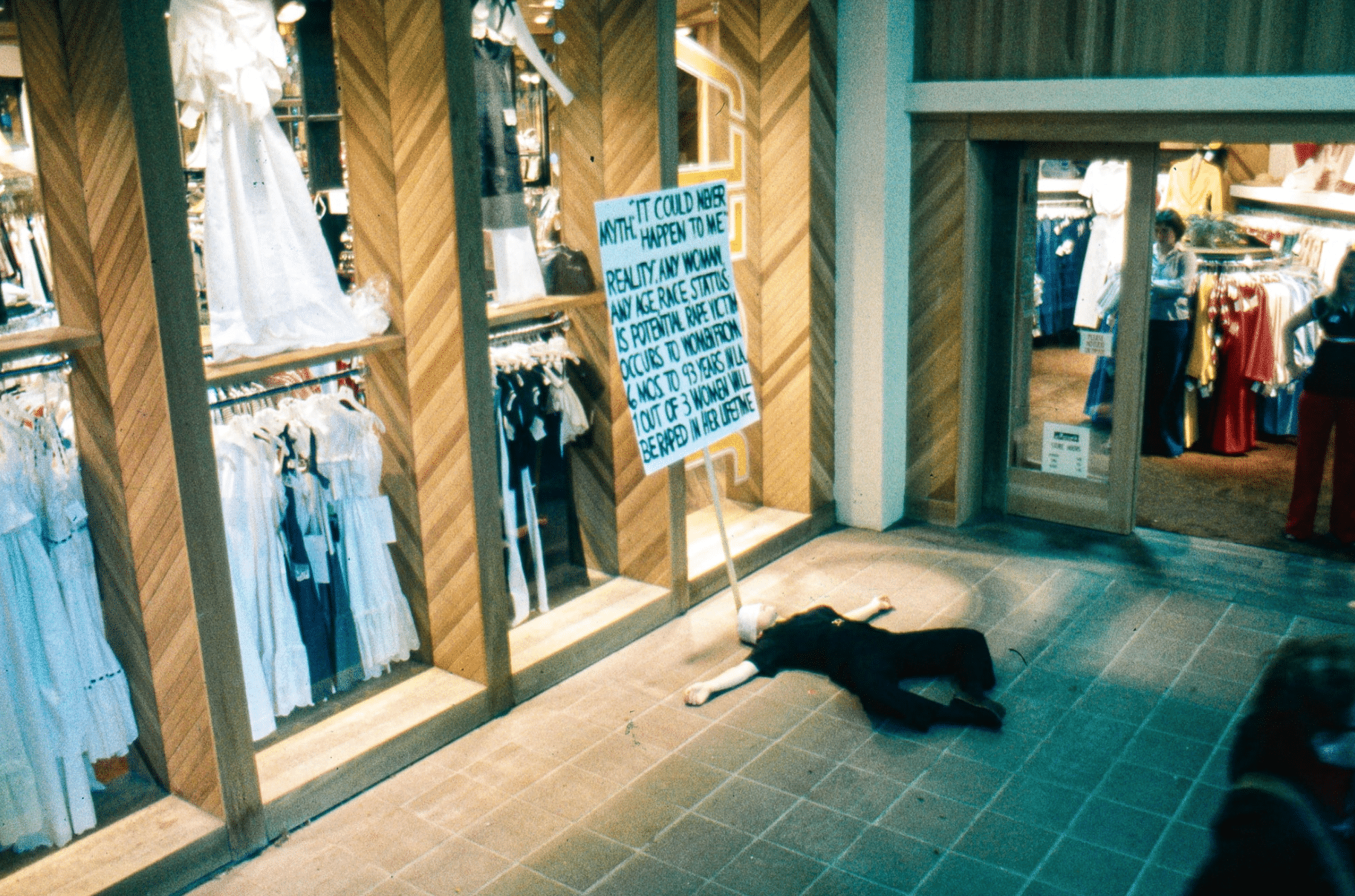
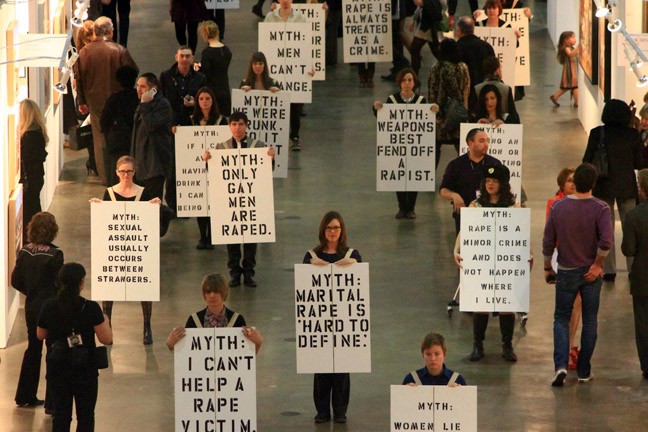
The second, and perhaps most in line with what I would imagine I would find, is a street-level action I remember vividly, as do many others. In her performance Carry that Weight, Columbia University student Emma Sulkowicz carried a 50lb twin size mattress strapped to her back everywhere she went on campus from September 2, 2014 to May 27, 2015. She created the work as a proclamation of her rape by a fellow student, after her attempts to have him held responsible through official university channels and her subsequent appeals were defeated. Hailed by the New York Times as “an artwork of last resort,” the performance drew attention both on and off campus. The artist’s clearly outlined Rules of Engagement stated that she had to carry the mattress every time she walked on campus, and that although she could not ask for help, she could accept it when offered. The mattress became a physical stand-in for the emotional weight of sexual abuse and the inescapable necessity of constantly living with the residue of trauma. As coverage of her performance spread, she was offered help with her burden by both male and female students and passersby. Thus the work served not only as a physical tool for personal catharsis and public announcement, but also as a method for personal and collective healing. And eventually, the performance ended and Sulkowicz was able to put the mattress down. 7 8
- https://www.nytimes.com/2014/09/22/arts/design/in-a-mattress-a-fulcrum-of-art-and-political-protest.html?fbclid=IwAR1hIkAcCLTZv4rVZAK4p52Jy6VVDwvX9hZxkHt7_x0M4-yuuSIDPxbdm_o
- http://www.emmasulkowicz.com/overview
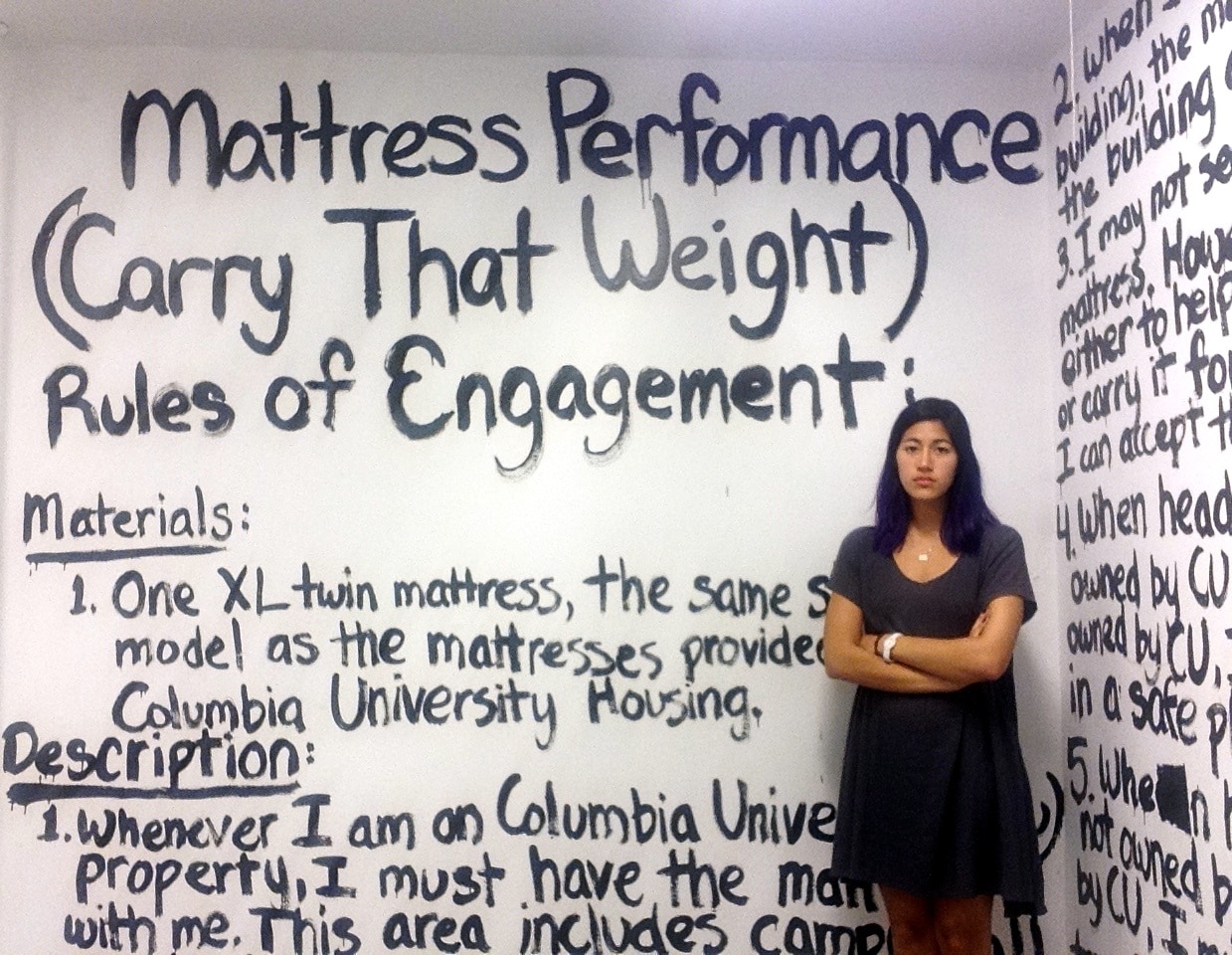


Carry that Weight is an undeniably powerful artwork, but it was completed in 2015 and much has happened in the arena of sexual assault and feminist political action since then. #metoo didn’t take center stage until nearly two years after Sulkowicz’s performance ended. With this strong example to follow, I assumed that there would exist many other performances of this embodied and direct nature addressing timely #metoo. Perhaps sexual assault and a woman’s right to choose is a final taboo in the world of performance art. Maybe these works do exist but often don’t receive the critical and media attention they deserve, and thus fall through the cracks of contemporary discourse. Or perhaps the events I mentioned are too recent and the development of artworks of this importance take time. Or maybe it’s simply that woman have publicly performed their trauma enough…


